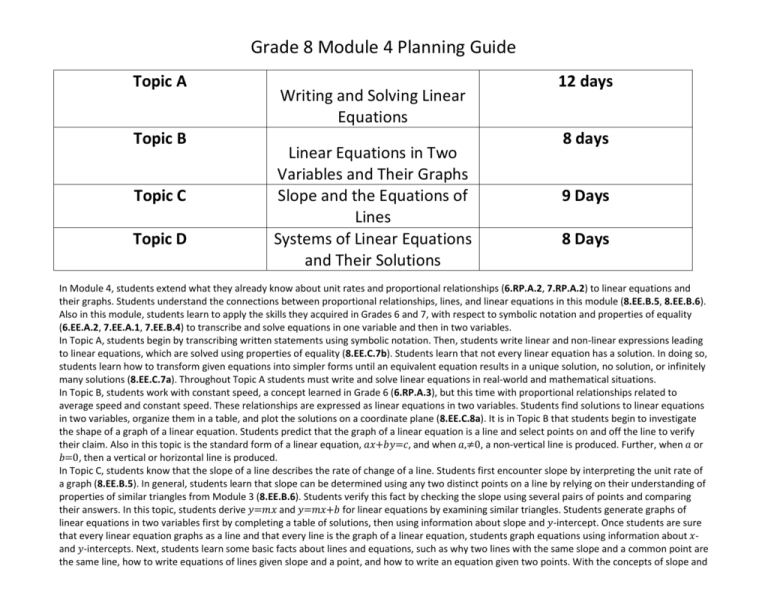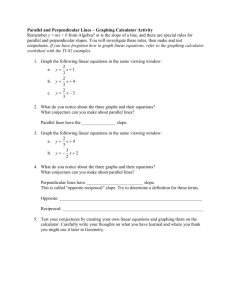Math 8 Module 4 Guidance
advertisement

Grade 8 Module 4 Planning Guide Topic A Topic B Topic C Topic D Writing and Solving Linear Equations Linear Equations in Two Variables and Their Graphs Slope and the Equations of Lines Systems of Linear Equations and Their Solutions 12 days 8 days 9 Days 8 Days In Module 4, students extend what they already know about unit rates and proportional relationships (6.RP.A.2, 7.RP.A.2) to linear equations and their graphs. Students understand the connections between proportional relationships, lines, and linear equations in this module (8.EE.B.5, 8.EE.B.6). Also in this module, students learn to apply the skills they acquired in Grades 6 and 7, with respect to symbolic notation and properties of equality (6.EE.A.2, 7.EE.A.1, 7.EE.B.4) to transcribe and solve equations in one variable and then in two variables. In Topic A, students begin by transcribing written statements using symbolic notation. Then, students write linear and non-linear expressions leading to linear equations, which are solved using properties of equality (8.EE.C.7b). Students learn that not every linear equation has a solution. In doing so, students learn how to transform given equations into simpler forms until an equivalent equation results in a unique solution, no solution, or infinitely many solutions (8.EE.C.7a). Throughout Topic A students must write and solve linear equations in real-world and mathematical situations. In Topic B, students work with constant speed, a concept learned in Grade 6 (6.RP.A.3), but this time with proportional relationships related to average speed and constant speed. These relationships are expressed as linear equations in two variables. Students find solutions to linear equations in two variables, organize them in a table, and plot the solutions on a coordinate plane (8.EE.C.8a). It is in Topic B that students begin to investigate the shape of a graph of a linear equation. Students predict that the graph of a linear equation is a line and select points on and off the line to verify their claim. Also in this topic is the standard form of a linear equation, 𝑎𝑥+𝑏𝑦=𝑐, and when 𝑎,≠0, a non-vertical line is produced. Further, when 𝑎 or 𝑏=0, then a vertical or horizontal line is produced. In Topic C, students know that the slope of a line describes the rate of change of a line. Students first encounter slope by interpreting the unit rate of a graph (8.EE.B.5). In general, students learn that slope can be determined using any two distinct points on a line by relying on their understanding of properties of similar triangles from Module 3 (8.EE.B.6). Students verify this fact by checking the slope using several pairs of points and comparing their answers. In this topic, students derive 𝑦=𝑚𝑥 and 𝑦=𝑚𝑥+𝑏 for linear equations by examining similar triangles. Students generate graphs of linear equations in two variables first by completing a table of solutions, then using information about slope and 𝑦-intercept. Once students are sure that every linear equation graphs as a line and that every line is the graph of a linear equation, students graph equations using information about 𝑥and 𝑦-intercepts. Next, students learn some basic facts about lines and equations, such as why two lines with the same slope and a common point are the same line, how to write equations of lines given slope and a point, and how to write an equation given two points. With the concepts of slope and Grade 8 Module 4 Planning Guide lines firmly in place, students compare two different proportional relationships. represented by graphs, tables, equations, or descriptions. Finally, students learn that multiple forms of an equation can define the same line. Simultaneous equations and their solutions are the focus of Topic D. Students begin by comparing the constant speed of two individuals to determine which has greater speed (8.EE.C.8c). Students graph simultaneous linear equations to find the point of intersection and then verify that the point of intersection is in fact a solution to each equation in the system (8.EE.C.8a). To motivate the need to solve systems algebraically, students graph systems of linear equations whose solutions do not have integer coordinates. Students use an estimation of the solution from the graph to verify their algebraic solution is correct. Students learn to solve systems of linear equations by substitution and elimination (8.EE.C.8b). Students understand that a system can have a unique solution, no solution, or infinitely many solutions, as they did with linear equations in one variable. Finally, students apply their knowledge of systems to solve problems in real-world contexts, including converting temperatures from Celsius to Fahrenheit. Grade 8 Module 4 Planning Guide Grade 8 Module 4 Planning Guide Grade 8 Module 4 Planning Guide Lesson Emphasize Standards Big Idea Released Items for NYS Test TOPIC A Lesson 1: writing equations using symbols Write math statements using symbols; know what written description they represent. Lesson 2: Knowing properties, transcribing Linear vs. Nonand identifying linear and nonLinear Expressions in linear equations x Lesson 3: Linear Equations in x Understand that a linear equation is a statement of equality between 2 expressions. Solutions are those numbers x that satisfy a given equation. Lesson 4: Solving a linear equation Using properties of equality to solve linear equations with rational coefficients. 8.EE.7 Solve linear equations in one variable. a. Give examples of linear equations in one variable with one solution, infinitely many solutions, or no solutions. Show which of these possibilities is the case by successively transforming the given equation into simpler forms, until an equivalent equation of the form 𝑥=𝑎, 𝑎=𝑎, or 𝑎=𝑏 results (where 𝑎 and 𝑏 are different numbers). b. Solve linear equations with rational number coefficients, including equations whose solutions require expanding expressions using the distributive property and collecting like terms. 2013-pg 5 2013-pg 19 2014-pg 78 2015-pg 21 2015-pg 27 Grade 8 Module 4 Planning Guide Lesson 5: SKIP Lesson 6: Solutions of a Linear equation Using distributive property of simplify equation. Not every linear equation has a solution. Lesson 7: What represents a linear equation Classification of with one solution, no solution, or solutions infinite solutions? Lesson 8: Linear Equations in Disguise Lesson 9: Focus on Exercises 3-9 on p. 100102 Grade 8 Module 4 Planning Guide TOPIC B Lesson Big Idea Lesson 10: A critical look at proportional relationships Using average and constant speed to write a linear equation in 2 variables, then answer questions about distance and time. Lesson 11: constant rate Seeing constant rate in context: Graphing points on a coordinate plane, defining constant rate using 2 variables (where one is time) Using a table to find solutions to linear equations and then plot on coordinate plane. Lesson 12: linear equations in two variables Emphasize Standards Released Items for NYS Test Suggested 2013-pg 35 8.EE.5 Problems Graph proportional relationships, interpreting the unit rate as the 2014-pg 88 slope of the graph. Compare two different proportional relationships represented in different ways. For example, compare a distance-time graph to a distance-time equation to determine which of two moving objects has greater speed. Grade 8 Module 4 Planning Guide Lesson 13: The graph of a linear equation in two variables Lesson 14: The graph of a linear equation – horizontal and vertical lines Find and plot solutions to linear equations on a coordinate plane to predict shape of a graph. linear Graphing Explaining shape equations in of graph in standard form termsproduce of a given that a linear equation. horizontal or vertical line. TOPIC C Lesson Big Idea Emphasize Standards Released Items for NYS Test Lesson 15: the slope of a nonvertical line Understanding that slope is the slant of a line, and that it represents a unit rate. 2013-pg 35 2014-pg 33 8.EE.5 Graph proportional relationships, interpreting the unit rate as the 2014-pg 88 2015-pg 13 slope of the graph. Compare two different proportional relationships represented in different ways. For example, compare 2015-pg 14 2015 pg. 39 a distance-time graph to a distance-time equation to determine which of two moving objects has greater speed. Lesson 16: the computation of the slope of a nonvertical line Using slope formula to compute slope, and similar triangles to explain why slope is the same between 2 distinct points. 8.EE.6 Use similar triangles to explain why the slope m is the same between any two distinct points on a non-vertical line in the coordinate plane; derive the equation 𝑦=𝑚x for a line through the origin and the equation 𝑦=𝑚x+𝑏 for a line intercepting the vertical axis at 𝑏. Grade 8 Module 4 Planning Guide Lesson 17 : the line joining two distinct points of the graph y = mx + b has slope m The line joining two distinct points of the graph of the linear equation 𝒚=𝒎𝒙+𝒃 has slope 𝒎. Lesson 18 : there is only one line passing through a given point with a given slope Understand that straight lines with the same slope and one common point are the same line, using equations in the form y=mx +b Lesson 19 : the graph of a linear equation in two variables is a line Using y=mx+b to show that a line is made up of a series of points. Skip Proofs Using intercepts is an easier way to graph a line than making a table of solutions. Grade 8 Module 4 Planning Guide Lesson 20: every Y=mx+b line is a graph of a represents any linear equation non-vertical line, with b as a constant. Write the equation that represents the graph of a line. Lesson 21: some Writing an facts about graphs equation when of a linear equation given 2 points and in two variables a slope. Know the Lesson 22: Constant rates revisited SKIP forms of a slope formula and slopeintercept equation. Students know that any constant rate problem can be described by a linear equation in two variables where the slope of the graph is the constant rate. TOPIC D Grade 8 Module 4 Planning Guide Lesson Lesson 24: Introduction to Simultaneous Equations Big Idea Understanding of systems of equations and notation. Comparing graphs for systems in the context of rate Lesson 25: Geometric interpretation of the solutions of a linear system Graphing equations to find point of intersection, identified as solution. Solution also determined by computation. Lesson 26: A System of Characterization of equations with no parallel lines solution will be parallel lines Lesson Big Idea Lesson 27: Nature of solutions of a system of linear equations Students must know if a system of equations has one unique solution, no solution, or infinitely many solutions. Emphasize Standards Released Items for NYS Test 8.EE.5 2013 pg. 1 Graph proportional relationships, interpreting the unit rate as the 2014 pg. 17 slope of the graph. Compare two different proportional 2014 pg. 49 relationships represented in different ways. For example, compare 2014 pg. 27 a distance-time graph to a distance-time equation to determine 2014 pg. 113 which of two moving objects has greater speed. 2015 pg. 2 2015 pg. 14 2015 pg. 19 8.EE.8 Analyze and solve pairs of simultaneous linear equations. a. Understand that solutions to a system of two linear equations in two variables correspond to points of intersection of their graphs, because points of intersection satisfy both equations simultaneously. b. Solve systems of two linear equations in two variables algebraically, and estimate solutions by graphing the equations. Solve simple cases by inspection. For example, 3𝑥+2𝑦=5 and 3𝑥+2𝑦=6 have no solution because 3𝑥+2𝑦 cannot simultaneously be 5 and 6. c. Solve real-world and mathematical problems leading to two linear equations in two variables. For example, given coordinates for two pairs of points, determine whether the line through the first pair of points intersects the line through the second pair. Grade 8 Module 4 Planning Guide Lesson 28: Another Computational Method of Solving a Linear System Lesson 29: Word Problems SKIP Lesson 30: Conversion between Celsius and Fahrenheit SKIP Elimination method, rational number properties using substitution to solve a system of linear equations. Writing and solving linear equation system word problems using substitution and elimination methods A real world application of linear equations.







